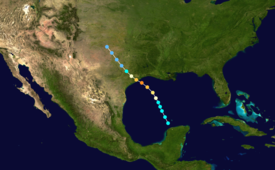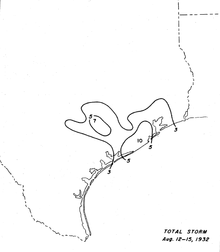1932 Freeport hurricane
| Category 4 major hurricane (SSHWS/NWS) | |
 Surface weather analysis of the storm on August 13 | |
| Formed | August 12, 1932 |
|---|---|
| Dissipated | August 15, 1932 |
| Highest winds | 1-minute sustained: 150 mph (240 km/h) |
| Lowest pressure | 935 mbar (hPa); 27.61 inHg |
| Fatalities | 40 |
| Damage | $7.5 million (1932 USD) |
| Areas affected | South-Central United States |
| Part of the 1932 Atlantic hurricane season | |
The 1932 Freeport hurricane was an intense tropical cyclone that primarily affected areas of the Texas coast in August of the 1932 Atlantic hurricane season. It was the second storm and first hurricane of the season, developing just off the Yucatán Peninsula on August 12. While moving to the northwest, the storm began to quickly intensify the next day. It rapidly intensified from a category 1 hurricane to a category 4 with winds estimated at 150 mph (240 km/h) and an estimated central pressure of 935 mbar (27.6 inHg) shortly before making landfall near Freeport, Texas, early on August 14. After landfall, the hurricane began to quickly weaken before dissipating over the Texas Panhandle.
The storm caused heavy rainfall inland, peaking at 9.93 in (252 mm) in Angleton. Record rainfall rates were also reported in some areas. Power outages were reported in Galveston and San Antonio. The storm caused $7.5 million in damages,[nb 1] mostly to crops, and 40 deaths.
Meteorological history

Tropical storm (39–73 mph, 63–118 km/h)
Category 1 (74–95 mph, 119–153 km/h)
Category 2 (96–110 mph, 154–177 km/h)
Category 3 (111–129 mph, 178–208 km/h)
Category 4 (130–156 mph, 209–251 km/h)
Category 5 (≥157 mph, ≥252 km/h)
Unknown
The Freeport hurricane was first noted by ships on August 12 as a tropical disturbance in the Gulf of Mexico.[1] However, it was suggested in later research that the disturbance may have originated from a low-pressure area between Belize and Honduras on August 11.[2] Steadily moving to the northwest, the storm began to intensify, reaching hurricane strength on August 13, and soon after reaching major hurricane strength later that day.[3] A report remarked that the storm was "phenomenal" due to the fact that previously the storm had "seemed to be of only moderate intensity" while near land before rapidly intensifying.[2]
The storm eventually reached winds of 145 mph (233 km/h), making it a Category 4 hurricane on the Saffir–Simpson scale.[2] The hurricane proceeded to make landfall early on August 14 just east of Freeport with winds of 150 mph (240 km/h).[2] A ship just offshore of the coast reported a minimum pressure of 942 mbar (27.8 inHg), but the official estimate for the hurricane's landfall intensity was set to 935 mbar (27.6 inHg) given the fact that the system was still rapidly intensifying at the time.[2] Due to the storm's small size, it quickly weakened to tropical storm strength later that day.[3] The storm finally weakened into a tropical depression before dissipating the next day over the Texas Panhandle.[2]
Preparations, impact, and aftermath
| Strongest U.S. landfalling tropical cyclones† | |||||
|---|---|---|---|---|---|
| Rank | Name‡ | Season | Wind speed | ||
| mph | km/h | ||||
| 1 | "Labor Day" | 1935 | 185 | 295 | |
| 2 | Karen | 1962 | 175 | 280 | |
| Camille | 1969 | ||||
| Yutu | 2018 | ||||
| 5 | Andrew | 1992 | 165 | 270 | |
| 6 | "Okeechobee" | 1928 | 160 | 260 | |
| Michael | 2018 | ||||
| 8 | Maria | 2017 | 155 | 250 | |
| 9 | "Last Island" | 1856 | 150 | 240 | |
| "Indianola" | 1886 | ||||
| "Florida Keys" | 1919 | ||||
| "Freeport" | 1932 | ||||
| Charley | 2004 | ||||
| Laura | 2020 | ||||
| Ida | 2021 | ||||
| Ian | 2022 | ||||
| Source: Hurricane Research Division[4] | |||||
| †Strength refers to maximum sustained wind speed upon striking land. | |||||
| ‡Systems prior to 1950 were not officially named. | |||||
In preparation for the storm, 150 vehicles evacuated out of Freeport, while water craft were taken up the Brazos River as far inland as possible.[5] 100 families in Caplen and Gilchrist were also evacuated. The 38th division of the Texas National Guard, stationed in Palacios, was alerted due to the oncoming storm.[6]

Heavy rainfall occurred across the coast and further inland due to the storm. Four locations set 24-hour rainfall records for the month of August, the highest of which was set near Angleton, recording 9.93 in (252 mm) of rain on August 13. Angleton also faced a water shortage after its pumping station was destroyed.[7] The remnants of the storm produced as much as 12 in (300 mm) of rain in Oklahoma.[6] Occupants in four vehicles were rescued by the United States Coast Guard near San Luis Pass.[5] In Wharton, 800 birds went missing in the heavy rain.[6] Galveston suffered primarily wind damage in the form of unroofed structures and broken windows. The Galveston Causeway was flooded by the heavy rain, preventing access from Galveston Island to the mainland.[5] Several other roads were blocked by fallen trees.[8] The city was also affected by a power outage after the storm caused loss of power and damaged communication lines.[9] In addition, communication lines in San Antonio were damaged.[5]
At William P. Hobby Airport in Houston, 11 planes were damaged when a hangar collapsed, resulting in losses of $250,000.[7] Hermann Park was also affected by the storm, where nine goats began to roam within the park due to a broken fence caused by a fallen limb.[10] 35 convicts were freed from the Ramsey Unit state prison during the storm due to the chance of the prison collapsing. However, after the storm, only eight returned to the prison, leaving 27 others missing.[11]
After the storm, the American Red Cross brought supplies to areas affected by the hurricane, requesting as much as $10,000 in relief work.[12] Several other local relief committees also brought supplies to affected areas.[13] An estimated $2 million in damages from the storm were attributed to crop damage alone, especially rice and cotton.[12] The storm was estimated to have killed 40 people and caused $7.5 million in damage.[6]
See also
Notes
- ^ All damage totals are in 1932 United States dollars unless otherwise noted.
References
- ^ Humphreys, W.J., ed. (November 3, 1932). "West Indian Hurricanes of August and September, 1932" (PDF). Monthly Weather Review. 60 (9). Washington, D.C.: Weather Bureau: 177–179. Bibcode:1932MWRv...60..177.. doi:10.1175/1520-0493(1932)60<177:TTSOAI>2.0.CO;2.
- ^ a b c d e f Landsea, Chris; et al. (April 2012). "Documentation of Atlantic Tropical Cyclones Changes to HURDAT". United States National Oceanic and Atmospheric Administration. Retrieved 9 August 2012.
- ^ a b "Atlantic hurricane best track (HURDAT version 2)" (Database). United States National Hurricane Center. April 5, 2023. Retrieved November 18, 2024.
 This article incorporates text from this source, which is in the public domain.
This article incorporates text from this source, which is in the public domain.
- ^ Landsea, Chris; Anderson, Craig; Bredemeyer, William; et al. (January 2022). Continental United States Hurricanes (Detailed Description). Re-Analysis Project (Report). Miami, Florida: Atlantic Oceanographic and Meteorological Laboratory, Hurricane Research Division. Retrieved November 18, 2024.
- ^ a b c d "Storm Threatens Gulf Coast". The Kingsport Times. Houston, Texas. Associated Press. 13 August 1932. Retrieved 13 August 2012.
- ^ a b c d Roth, David M; Hydrometeorological Prediction Center. Texas Hurricane History (PDF). United States National Oceanic and Atmospheric Administration's National Weather Service. Retrieved 12 August 2012.
- ^ a b Jones, Stuart E. (15 August 1932). "Hurricane Vents Fury; 23 Known Dead; Aid Sought". Berkeley Daily Gazette. Houston, Texas. United Press. pp. 1, 7. Retrieved 12 August 2012.
- ^ "22 Known Dead as Hurricane Sweeps Texas". Southeast Missourian. Houston, Texas. Associated Press. 15 August 1932. Retrieved 12 August 2012.
- ^ "Seventeen Dead After Hurricane". Spokane Daily Chronicle. Houston. Associated Press. 15 August 1932. Retrieved 13 August 2012.
- ^ Berger, Eric (25 July 2012). "Let's hope history doesn't repeat itself: The 1932 hurricane". The Houston Chronicle. Retrieved 12 August 2012.
- ^ "Ordered to Run, Prisoners Do It". Spokane Daily Chronicle. Huntsville, Texas. Associated Press. 17 August 1932. Retrieved 13 August 2012.
- ^ a b "Texas Hurricane Death Toll Now 32". The Daily Sun. Houston, Texas. Associated Press. 16 August 1932. Retrieved 12 August 2012.
- ^ "Hurricane Relief Work Is Pressed". The Daily Record. Houston. Associated Press. 17 August 1932. Retrieved 12 August 2012.

